Black excellence: six artworks you must see at OMCA
Black excellence, the celebration of triumph and ascendancy in the Black community, is a mentality backed by actions of leadership and perseverance. As part of OMCA’s reimagination of the collection-building process from one that was largely passive to one that actively engages and prioritizes individuals who are often marginalized and excluded from cultural institutions, we present four recent acquisitions that exemplify Black excellence along with two pieces from OMCA’s collection.
Many of these pieces address the pervasiveness of systems of white supremacy and police violence against Black people while also bringing into focus strength, tenderness, and endurance against anti-Black racism and violence which has been a part of our country’s ongoing legacy.
To see some of these artworks on view at OMCA, purchase admission tickets.
Arbie Williams, Mamaloo, 1992
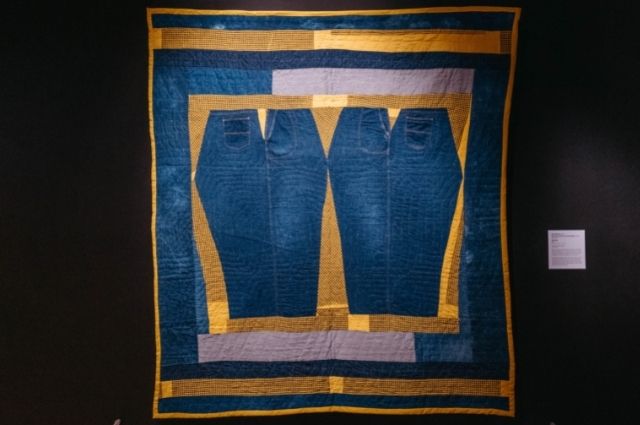
Nationally-celebrated “britches” quiltmaker Arbie Williams (1916–2003) incorporated salvaged pants into her textiles. Mamaloo, first featured in the exhibition Mothership: Voyage into Afrofuturism is now a part of OMCA’s collection, and was made from a pair of discarded jeans found on 14th Avenue in Oakland.
Born in Louisiana and relocated to Oakland in the 1940s, Williams made quilts out of necessity from a young age. Her freestyle designs emphasized everyday materials and are often compared to funk or jazz. Drawing from Southern Black American traditions, quilts often commemorate events that symbolize abundant futures, such as marriages, births, and new homes. They represent the sustenance of Black people, as they literally keep folks warm and cared for. Was on view in Mothership: Voyage Into Afrofuturism
Rashaad Newsome, Parenting While Black, 2020
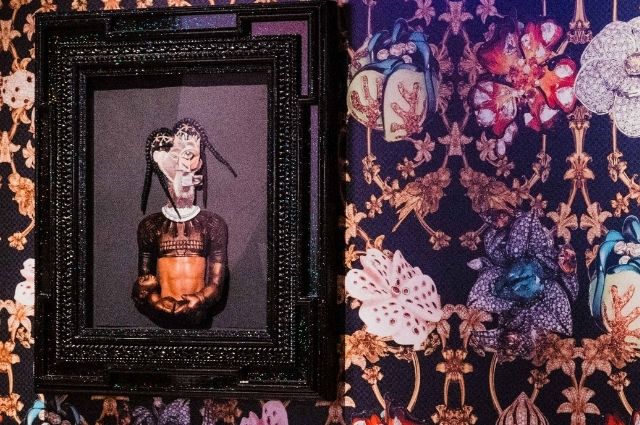
Like OMCA, Rashaad Newsome applies a multidisciplinary approach to his practice. His work is often referred to as collage but it actually lives somewhere between collage, assemblage, sculpture, and performance and blends Black and queer cultural histories and traditions into his art.
As a Black queer man from a working-class background, his practice recognizes that people are disadvantaged by multiple sources of oppression. His work seeks to construct a new cultural framework of power that reclaims a space for the complex convergence of identity markers.
Newsome wrote, “In Parenting While Black, I was thinking a lot about the murders of Black people happening at that same time, eg. Ahmaud Arbery, Breonna Taylor, George Floyd, and so many others at the hands of white supremacists and the police. I couldn’t stop thinking about those who they left behind, particularly the parents. I don’t have a child, but I imagine losing a child to a hate crime is one of the worst griefs a person could carry. I believe the act of parenting for anyone involves a certain amount of stress. However, Black parents have the constant burden of worrying about if what they teach their children about protecting themselves from a world that does not believe their life matters will be enough. The anxiety that some unexpected scenario catches the child off guard and costs them their life is crippling, and far too often, no matter what they do to prepare the child for a cruel world, they still meet violence. This reality is what I was trying to imagine in Parenting While Black.”
Newsome is originally from New Orleans, Louisiana, but he was drawn to California, and Oakland in particular, like so many other artists and free thinkers for its rich cultural history. His journey and practice reflects the diversity of identities in California and the many reasons people migrate here. This piece incorporates a personal story within a global context. It embodies the anxieties of 2020, while also presenting a confident image of the complexities of Black intersectionality. Was on view in Mothership: Voyage Into Afrofuturism
Phillip Lindsay Mason, Rainbow Dream, 1970
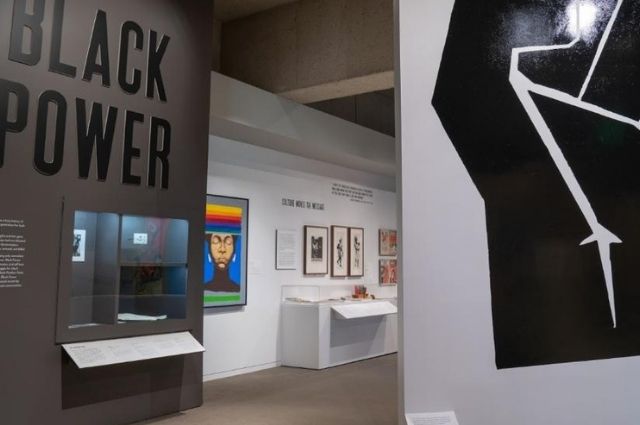
Philip Lindsay Mason attended UC Berkeley in the late 1960s. Like others in the Black Arts Movement, Mason used art as a platform to explore the power of self-representation. In 1968 Mason wrote, “My work will be black because my work springs from the context of my experience. The experience of a black man and a black artist.”
While Mason is from Oakland, he remains somewhat of a mystery and not much is known about him.
On view in the Black Power installation in the Gallery of California History
Binta Ayofemi, Portals, 2021
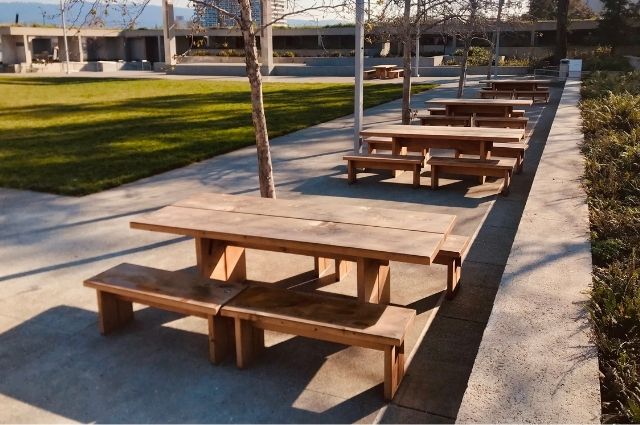
To support the Museum’s vision to provide visitors with a more welcoming environment, OMCA commissioned local artist and designer Binta Ayofemi to create furniture for both interior and exterior spaces on campus. Ayofemi’s designs, which are inspired in part by the culture and history of Oakland, are intended to encourage a more comfortable and longer visitor experience.
“I wanted to respond to how the museum opens to the Lake, which leads to the Ocean. The Museum becomes a portal open to a layered ecosystem, amplifying the present and the future at these thresholds where the building becomes open to a natural flow,” says Binta Ayofemi of the Portals she created for OMCA. “My installation responds to the Museum’s distinctive pavilions as portals to activate the senses, and expresses Black and Indigenous spaces through regenerative power and Oakland’s built environment.”
Each of Ayofemi’s Portals evoke a sense of restoration and transformation, and create collective space for gathering. This is suggested through seating as a base of restoration, as well as plinths, tables, and benches built from local cedar and redwood which are framed by moments of iridescent steel and mounds of herbaceous plants and herbs.
Oakland-based visual artist and designer, Ayofemi shapes new urban forms and urban materials, evoking power, Black space, and the senses. Ayofemi’s works infuse an Afrofuturist narrative with objects and experiences gathered, honed, milled and performed. Ayofemi explores movement, making, manufacturing, and authorship of public and private space. Ayofemi’s activation of vacant sites, from an urban meadow to a reimagined corner store, suggests a state of mutability and transformation. Her work has been featured by Untitled, the Kadist Foundation, SFMOMA, the Carpenter Center, the Wattis Institute, the Asian Art Museum, the New Museum, dOCUMENTA, the British Arts Council, Rebuild Foundation, the AIA, the City of Oakland, and as a community partner of Black Cultural Zone. On view in OMCA’s Garden
Walter Gordon Phillips, The Pavers, 1963
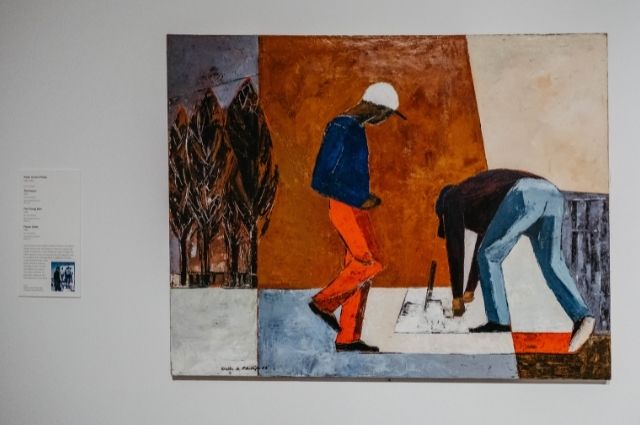
Three paintings by San Francisco-born artist Walter Gordon Phillips hang in the Gallery of California Art’s Pluralism/Identity section. He often used scenes from everyday life and photographs or sketches as inspiration for his work. The three paintings in the gallery, Five Young Men, Flower Seller, and The Pavers, display his style of capturing these singular moments. Walter Gordon Phillips is not widely known as an artist, and he made art while pursuing a long career in education, most notably at Laney College. He often painted scenes of everyday life and regularly took his subjects from photographs or sketches. Phillips used a palette knife rather than a brush to achieve the bold strokes of paint that define his artwork. His style combines his personal viewpoint and the influences of his time. On view in the Gallery of California Art
Kahlil Joseph, BLKNWS, 2019
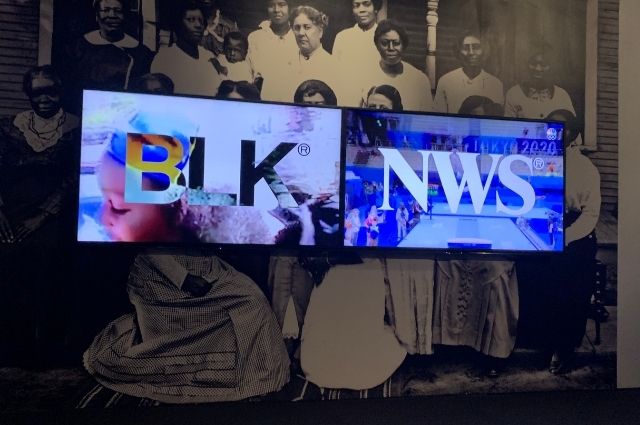
BLKNWS first appeared at the Venice Biennale in 2019, where it figured in the main exhibition.
Created by filmmaker Kahlil Joseph who was raised in Sacramento and is now based in L.A., BLKNWS is a two channel fugitive newscast that presents an alternative model to the mainstream news industry. It takes a global perspective based on the notion that “news” is not just current events and op-eds, but anything that’s new to you or hasn’t been widely known before. View a short segment of the piece here.
BLKNWS initially shown as part of Mothership: Voyage Into Afrofuturism and the original vision with Kahlil’s team was to install a series of satellite installations of BLKNWS around Oakland. This initiative was driven by the concept of Mundane Afrofuturism, which rejoices in everyday Black life. With BLKNWS strategically placed in environments that the public can happen upon, the goal is to assert an affirming narrative to Black life and at the same time undermine anti-Black narratives.
OMCA could not follow through with this proposal entirely because it was too costly for this project, so the curators settled on a single off-site installation in the lobby of Laney College. Unfortunately, when the pandemic hit, Laney shut their doors so the installation was pulled. This was when we settled on the garden as the public space to share this media. The BLKNWS team was ultimately able to realize the vision of satellite locations in their partnership with the Hammer Museum and Made in LA.
Joseph is an internationally-recognized artist and filmmaker and currently serves as Vice President of the board at The Underground Museum in LA. BLKNWS has been shown at museums and biennials worldwide, and may become a feature-length film. Was on view in Mothership: Voyage Into Afrofuturism